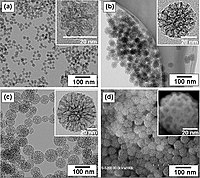
Photo from wikipedia
Mössbauer spectroscopy, as well as magnetic measurements and transmission electron microscopy, was employed to investigate the particle size and magnetic and structural properties of Co–Ni spinel ferrites synthesized via a… Click to show full abstract
Mössbauer spectroscopy, as well as magnetic measurements and transmission electron microscopy, was employed to investigate the particle size and magnetic and structural properties of Co–Ni spinel ferrites synthesized via a succession of chemical co-precipitation, hydrothermal treatment, and etching in hydrochloric acid (HCl). A maximum coercive force of 519 kA/m and saturation magnetization of $60.4~\text {A}\cdot \text {m}^{2}$ /kg were obtained after etching in HCl with a concentration of 4 mol/L. At room temperature, the samples obtained after co-precipitation showed partially paramagnetic behavior; however, this effect disappeared in the Mössbauer spectra at liquid He temperature. The area ratio of the Fe ions at A-sites and B-sites changed as particle size was increased, indicating that the cation distribution is changed as a result of the size and synthesis method. After the final stage of synthesis, i.e., etching, the degree of inversion was found to be 1, indicating that the structure is a completely inverse spinel. It is expected that the cation distribution, especially the increase of Co2+ in the octahedral site, produces a higher magnetocrystalline anisotropy and thus higher coercivity.
Journal Title: IEEE Transactions on Magnetics
Year Published: 2018
Link to full text (if available)
Share on Social Media: Sign Up to like & get
recommendations!